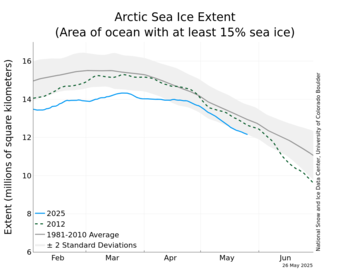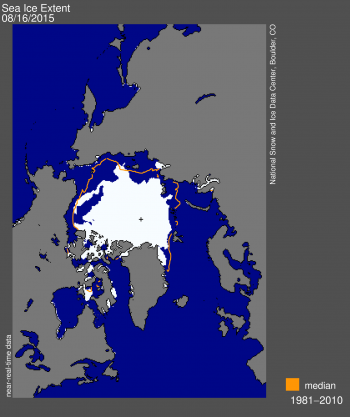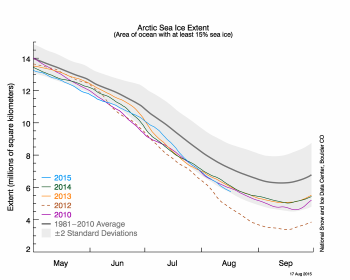http://nsidc.org/data/seaice_index/images/daily_images/N_stddev_timeseries_thumb.png (from the National Snow and Ice Datacenter).

On August 16, 2015 sea ice extent stood at 5.79 million square kilometers (2.24 million square miles). This is 1.35 million square kilometers (521,200 square miles) below the 1981 to 2010 average, and 1.17 million square kilometers (451,700 square miles) above the level for the same date in 2012, the year of the record low extent.
http://nsidc.org/arcticseaicenews/files/2015/08/Figure1-350×417.png

Again, it seems unlikely the low ice record of 2012 is going to be broken this year, but the trends are still clear.
http://nsidc.org/arcticseaicenews/files/2015/08/Figure2-350×280.png

Meanwhile, it appears that ANTarctic winter is going to be relatively mild this year…
There is a pretty compelling graphic illustrating this at
http://nsidc.org/arcticseaicenews/
which, for some reason, I seem unable to display here.
Growth in Antarctic sea ice extent has leveled off, increasing by just 250,000 square kilometers (96,500 square miles) between August 1 and August 17. This slow rate of growth has brought this year’s sea ice extent to below the 1981 to 2010 average for the first time in nearly four years.
I fear the repeated record high global average temperatures we have been receiving the last few years (we just came off the hottest July since records have been collected) may have something to do with this. Remember, “global average temperature” takes into account both the summer AND winter hemispheres of the planet. The hope that increasing Antarctic winter sea ice might compensate for losses in the summer Arctic Ocean seems to be melting away.
To paraphrase George R. R. Martin…Summer is coming.